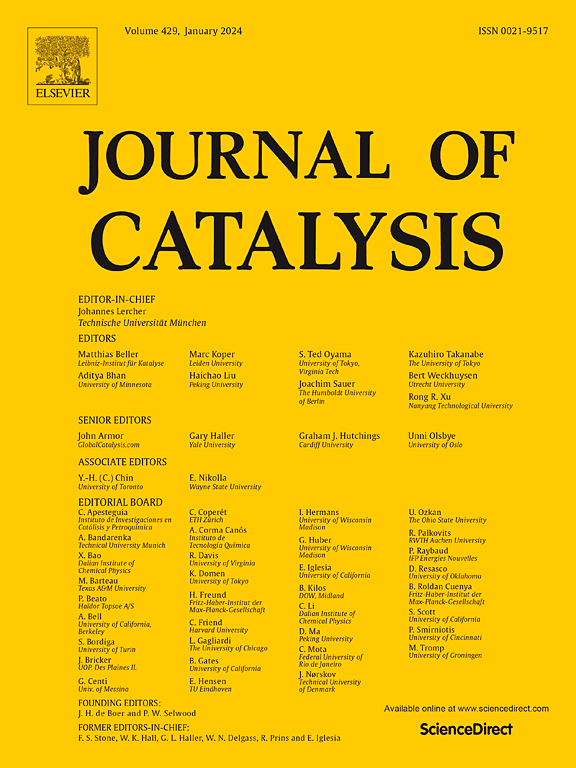Tuning oxygen vacancy defects in VOx/Ce1-xLaxO2−δ nanorod catalysts through La doping for selective methanol oxydehydrogenation to dimethoxymethane
IF 6.5
1区 化学
Q2 CHEMISTRY, PHYSICAL
引用次数: 0
Abstract
Methanol oxydehydrogenation to produce dimethoxymethane (DMM) and its use as a key feedstock for the synthesis of PODE3-5, an emerging diesel additive, represents a promising strategy for mitigating diesel exhaust emissions. However, achieving high methanol conversion with high selectivity for DMM remains a significant challenge at low temperatures. Herein, a La-doped ceria-supported vanadia (VOx/Ce1-xLaxO2-δ) nanorod catalyst was prepared by a one-step hydrothermal method to create sufficient asymmetric oxygen vacancies. Diverse techniques were employed to comprehensively analyze the catalyst structure and active sites. The results indicate that the generated oxygen vacancies not only activate oxygen species but also accelerate the cleavage of O–H and C–H bonds alongside V5+ active site within the adsorbed methanol during the methanol oxydehydrogenation reaction. The VOx/Ce0.8La0.2O2-δ catalyst demonstrated superior catalytic efficiency, achieving 81 % methanol conversion and 95 % selectivity for dimethoxymethane under atmospheric pressure and at 200 °C in a fixed-bed reactor.


通过La掺杂调整VOx/Ce1-xLaxO2−δ纳米棒催化剂的氧空位缺陷,选择性甲醇氧化脱氢制二甲氧基甲烷
甲醇氧化脱氢法制备二甲氧基甲烷(DMM),并将其作为合成新型柴油添加剂PODE3-5的关键原料,代表了一种很有前景的减少柴油尾气排放的策略。然而,在低温下实现高甲醇转化率和高选择性的DMM仍然是一个重大挑战。本文采用一步水热法制备了一种la掺杂的氧化铈负载钒(VOx/Ce1-xLaxO2-δ)纳米棒催化剂,以产生足够的不对称氧空位。采用多种技术对催化剂结构和活性位点进行了综合分析。结果表明,在甲醇氧化脱氢反应中产生的氧空位不仅激活了氧,而且加速了吸附甲醇中沿V5+活性位点的O-H和C-H键的断裂。VOx/Ce0.8La0.2O2-δ催化剂表现出优异的催化效率,在常压和200 °C的固定床反应器中,甲醇转化率为81% %,二甲氧基甲烷选择性为95% %。
本文章由计算机程序翻译,如有差异,请以英文原文为准。
求助全文
约1分钟内获得全文
求助全文
来源期刊

Journal of Catalysis
工程技术-工程:化工
CiteScore
12.30
自引率
5.50%
发文量
447
审稿时长
31 days
期刊介绍:
The Journal of Catalysis publishes scholarly articles on both heterogeneous and homogeneous catalysis, covering a wide range of chemical transformations. These include various types of catalysis, such as those mediated by photons, plasmons, and electrons. The focus of the studies is to understand the relationship between catalytic function and the underlying chemical properties of surfaces and metal complexes.
The articles in the journal offer innovative concepts and explore the synthesis and kinetics of inorganic solids and homogeneous complexes. Furthermore, they discuss spectroscopic techniques for characterizing catalysts, investigate the interaction of probes and reacting species with catalysts, and employ theoretical methods.
The research presented in the journal should have direct relevance to the field of catalytic processes, addressing either fundamental aspects or applications of catalysis.
 求助内容:
求助内容: 应助结果提醒方式:
应助结果提醒方式:


